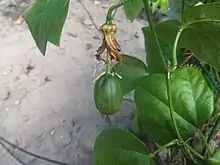Passiflora herbertiana
Passiflora herbertiana, or native passionfruit, is a widespread climbing twiner native to moist forests on the coast and ranges of eastern Australia. The subspecies P. h. insulae-howei P.S.Green is endemic to Lord Howe Island in the Tasman Sea.[1]
| Native passionfruit | |
|---|---|
 | |
| Flowers | |
 | |
| Unripe native passion fruit | |
| Scientific classification | |
| Kingdom: | Plantae |
| Clade: | Tracheophytes |
| Clade: | Angiosperms |
| Clade: | Eudicots |
| Clade: | Rosids |
| Order: | Malpighiales |
| Family: | Passifloraceae |
| Genus: | Passiflora |
| Species: | P. herbertiana |
| Binomial name | |
| Passiflora herbertiana | |
Description
The leaves are usually 3-lobed usually with a slightly hairy undersurface; 6–12 cm long; with petioles mostly 1.5–4 cm long, with 2 glands at the apex. Stipules are linear, mostly 1–3 mm long. The flowers are 6 cm wide and yellow to orange. The following green berry is 50 mm long with pale spots.[2]
The insulae-howei subspecies is similar: the leaves are usually 4–8 cm long and 5–8 cm wide. The solitary, orange-yellow to greenish flowers, 60 mm across, appear from October to March. The oval green fruits are 40–50 mm long; they are edible but sickly-sweet.[1][3]
Distribution and habitat
The insulae-howei subspecies is endemic to Australia’s subtropical Lord Howe Island in the Tasman Sea, where it is widespread.[1][3]
Flammability & building protection
Passiflora herbertiana is included in the Tasmanian Fire Service's list of low flammability plants, indicating that it is suitable for growing within a building protection zone.[4]
References
- "Passiflora herbertiana subsp. insulae-howei". Flora of Australia Online: Data derived from Flora of Australia Volume 49 (1994). Australian Biological Resources Study (ABRS). Retrieved 2014-02-27.
- Passiflora herbertiana plant profile, PlantNET
- Hutton, Ian (1998). The Australian Geographic Book of Lord Howe Island. Sydney: Australian Geographic. p. 143. ISBN 978-1-876276-27-0.
- Chladil and Sheridan, Mark and Jennifer. "Fire retardant garden plants for the urban fringe and rural areas" (PDF). www.fire.tas.gov.au. Tasmanian Fire Research Fund.